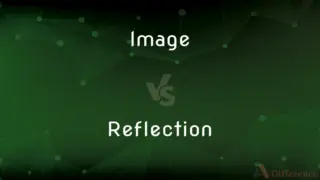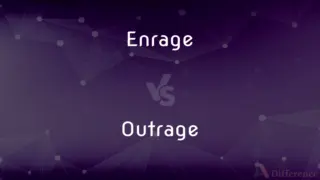Reticule vs. Reticle — What's the Difference?
By Fiza Rafique & Urooj Arif — Updated on April 1, 2024
A reticule is a small handbag, while a reticle refers to the crosshairs or aiming point in an optical instrument like a telescope or rifle scope.

Difference Between Reticule and Reticle
Table of Contents
ADVERTISEMENT
Key Differences
Reticules, historically known as small handbags or purses carried by women, were fashionable accessories that evolved from the netted bags of the 18th century to various forms. They were used to carry personal items such as money, calling cards, or beauty essentials. In contrast, a reticle is a technical term used in optics to describe the crosshairs, grids, or aiming points inscribed on the eyepiece of optical instruments, including telescopes, microscopes, and rifle scopes. These markings assist in aiming, measurement, or observation, playing a crucial role in precision tasks.
Reticules reflected social status and fashion trends, often elaborately designed with embroidery, beads, or fine fabrics, signaling the wearer's style and class. On the other hand, reticles are designed for functionality and accuracy, made from wire, etched glass, or projected digitally within the optical device. They are critical in fields like astronomy, photography, and shooting, where precise alignment and targeting are required.
While the term reticule has largely fallen out of common usage, replaced by more modern terms like "handbag" or "purse," reticles continue to be a vital component in optical technology, with advancements focusing on enhancing visibility, accuracy, and user interface. The distinction between reticule and reticle not only highlights the difference in their applications fashion versus optical science but also marks the evolution of language and technology over time.
Choosing between "reticule" and "reticle" depends on the context: for discussions related to fashion accessories, "reticule" is appropriate, while "reticle" is used when referring to optical instruments and aiming mechanisms.
Comparison Chart
Definition
A small handbag or purse
Crosshairs or aiming point in an optical instrument
ADVERTISEMENT
Use
Carrying personal items
Aiming, measurement, or observation in optical devices
Origin
Fashion accessory
Optical science
Material
Fabric, beads, embroidery
Wire, etched glass, digital projections
Significance
Social status, fashion
Precision, functionality
Modern Usage
Replaced by "handbag" or "purse"
Vital in technology and optical devices
Compare with Definitions
Reticule
Used in literature and historical accounts to denote a woman's handbag.
In her diary, she mentioned forgetting her reticule at the opera.
Reticle
Essential for precision in aiming, measurement, or observation.
Astronomers use telescopes with reticles for accurate star mapping.
Reticule
Often elaborately decorated, reflecting fashion trends and social status.
The museum's exhibit displayed reticules adorned with intricate beadwork from the 19th century.
Reticle
Can be made from wire, etched glass, or digitally projected.
Modern rifle scopes feature a digitally projected reticle for improved visibility.
Reticule
Varied in design, material, and size over the years.
Her antique reticule collection featured pieces from velvet to embroidered silk.
Reticle
Used in various fields, including astronomy, photography, and shooting.
The photographer's camera had a reticle in the viewfinder for framing shots.
Reticule
A small handbag or purse, historically used by women to carry essentials.
She carried a silk reticule that matched her gown to the ball.
Reticle
Design and technology advancements focus on enhancing functionality.
The new microscope reticle allowed for more precise measurements of specimens.
Reticule
Evolved from practical netted bags to stylish accessories.
Reticules became a symbol of feminine elegance during the Regency era.
Reticle
The crosshairs or aiming point in the eyepiece of an optical instrument.
The sniper adjusted the reticle of his scope to align with the target.
Reticule
A drawstring handbag or purse.
Reticle
A reticle, or reticule also known as a graticule, is a pattern of fine lines or markings built into the eyepiece of an optical device such as a telescopic sight, spotting scope, theodolite, optical microscope or the screen of an oscilloscope, to provide measurement references during visual inspections. Today, engraved lines or embedded fibers may be replaced by a digital image superimposed on a screen or eyepiece.
Reticule
A reticle.
Reticle
A grid or pattern placed in the eyepiece of an optical instrument, used to establish scale or position. Also called graticule.
Reticule
A reticle; a grid in the eyepiece of an instrument.
Reticle
A grid, network, or crosshatch found in the eyepiece of various optical instruments to aid measurement or alignment
Reticule
A small women's bag made of a woven net-like material.
Reticle
(obsolete) a little bag
Reticule
A little bag, originally of network; a woman's workbag, or a little bag to be carried in the hand.
Reticle
A small net.
Reticule
A system of wires or lines in the focus of a telescope or other instrument; a reticle.
Reticle
A reticule. See Reticule, 2.
Reticule
A woman's drawstring handbag; usually made of net or beading or brocade; used in 18th and 19th centuries
Reticle
A network of fine lines, dots, cross hairs, or wires in the focal plane of the eyepiece of an optical instrument
Reticule
A network of fine lines, dots, cross hairs, or wires in the focal plane of the eyepiece of an optical instrument
Common Curiosities
What materials were historically used to make reticules?
Historically, reticules were made from various materials, including silk, velvet, leather, and were often embellished with beads, embroidery, and lace.
How do reticles improve accuracy in optical devices?
Reticles improve accuracy by providing a precise aiming point or reference marks for measurement, essential in tasks requiring pinpoint precision.
What is the significance of reticles in modern technology?
In modern technology, reticles are crucial for precision in a wide range of applications, from scientific research to recreational and professional shooting, representing advancements in optical engineering.
Why do some optical instruments have more than one reticle?
Some optical instruments feature multiple reticles to accommodate different magnification levels, aiming requirements, or measurement tasks, enhancing versatility and accuracy.
When did reticules become popular in fashion?
Reticules became popular in the late 18th century, coinciding with fashion trends that favored slimmer silhouettes, making traditional pockets impractical.
Can reticles be customized for specific applications?
Yes, reticles can be customized with different patterns, illumination, and magnification levels to suit specific needs, such as long-range shooting or detailed scientific observation.
Are reticles visible in all optical devices?
Reticles are designed to be clearly visible within the eyepiece of optical devices, though their visibility and design can vary widely depending on the device's purpose and technology.
How has the design of reticules and reticles evolved over time?
Reticules evolved from simple netted bags to elaborate fashion statements, while reticles have seen technological advancements in materials and projection methods for enhanced precision.
Can the term "reticule" still be used in contemporary language?
While "reticule" is considered archaic, it may still be used in historical or literary contexts to evoke a sense of period-specific fashion or elegance.
What factors influence the choice of reticle in a scope?
The choice of reticle in a scope is influenced by the intended use, such as hunting or target shooting, user preference for simplicity or detailed markings, and the need for illumination in low-light conditions.
Share Your Discovery

Previous Comparison
Image vs. Reflection
Next Comparison
Enrage vs. OutrageAuthor Spotlight
Written by
Fiza RafiqueFiza Rafique is a skilled content writer at AskDifference.com, where she meticulously refines and enhances written pieces. Drawing from her vast editorial expertise, Fiza ensures clarity, accuracy, and precision in every article. Passionate about language, she continually seeks to elevate the quality of content for readers worldwide.
Co-written by
Urooj ArifUrooj is a skilled content writer at Ask Difference, known for her exceptional ability to simplify complex topics into engaging and informative content. With a passion for research and a flair for clear, concise writing, she consistently delivers articles that resonate with our diverse audience.
















































